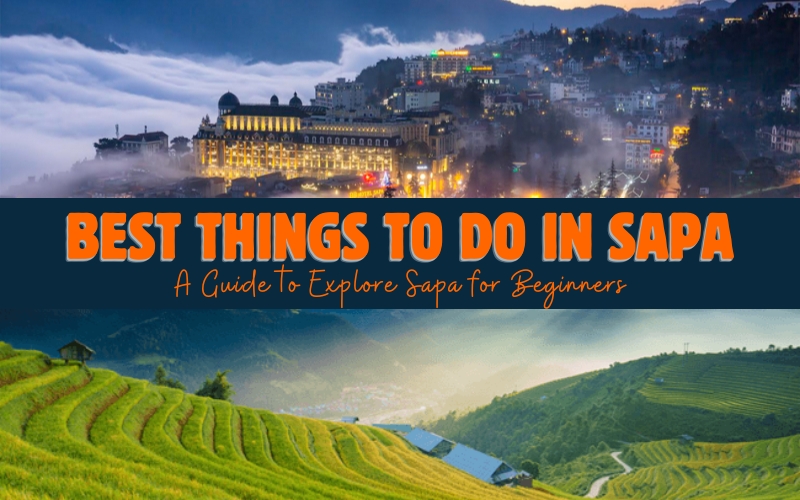
Sapa, the tourist paradise of Northern Vietnam, is blessed with majestic and poetic beauty by nature. This place is not only famous for its majestic mountain ranges and golden terraced fields, but is also an ideal destination for those who love to explore nature. The following are carefully selected experiences, promising to bring you the most complete vacation in Sapa, Vietnam. Whether you love exploring the mountains and forests or are passionate about learning about the culture of ethnic minorities, the suggestions of things to do in Sapa below will help you have unforgettable memories throughout your journey.
Best time to visit Sapa
Sapa is one of the few tourist destinations in Vietnam that can be visited at any time of the year due to its high altitude. The climate in Sapa is fresh and cool all year round, with the average temperature in Sapa usually fluctuating around 25 degrees Celsius, even in the summer months. Each season of the year, Sapa will have different natural landscapes. Therefore, no matter what time you choose to visit, Sapa always welcomes you with unique and unforgettable experiences.
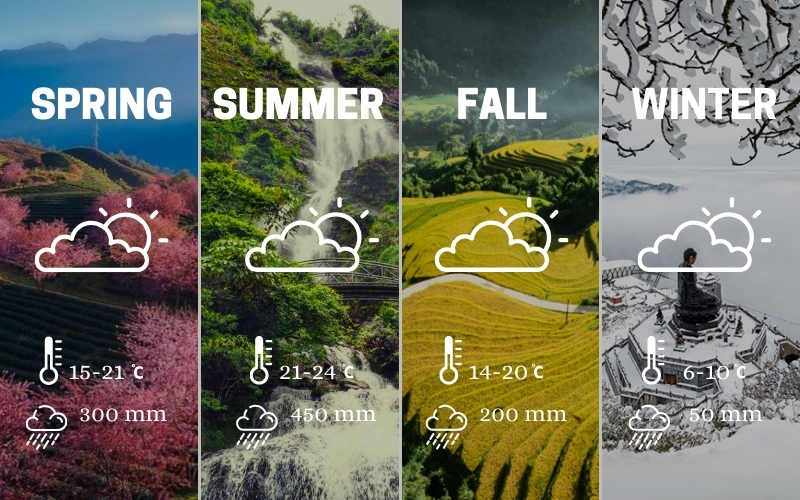
General weather of 4 seasons in Sapa
- March to May (Spring): This is one of the best times to visit. The weather is cool and pleasant, with misty mornings and light sunshine in the afternoons. It’s also flower season with white apricot blossoms, peach flowers, and pink rhododendrons bloom across villages and hillsides, making trekking especially scenic.
- June to September (Summer): Perfect for seeing the famous green rice terraces at their fullest. Temperatures average around 22–23°C, and waterfalls are strong and majestic. However, late summer brings heavier rainfall, so it’s best to avoid planning your trip too close to September.
- October to November (Autumn): this season is a favorite among travelers and also one of the most beautiful seasons of the year in Sapa. Rain is rare with clear blue skies, crisp air, and golden harvest landscapes make this a perfect time for photography and trekking.
- December to February (Winter): Expect real mountain cold because temperatures can drop to 3°C or even below zero. Sometimes, it snows, turning Sapa into a frosty fairytale. The town often floats in a sea of clouds, creating a magical and mystical atmosphere for those who don’t mind the chill.
Best things to do in Sapa
Conquer the roof of Indochina, Fansipan peak

Breathtaking panoramic view from the summit of Fansipan, “the roof of Indochina”
When going to Sapa, you definitely cannot miss Fansipan – the highest mountain in Vietnam, known as the “roof of Indochina”. For adventurous and exploratory tourists, conquering Fansipan peak always brings indescribable appeal. To conquer Fansipan peak, you have 2 options to choose from. Option 1 is for those who love to travel and enjoy, without spending too much energy, you will travel to the top by cable car and enjoy the impressive panoramic view of famous landmarks in Sapa such as Muong Hoa valley, Hoang Lien Son mountain range, …
The second option is to travel by mountain road, for those who love to explore with the mountain climbing experience for those who are in good health, have high endurance and a passion for trekking. You will experience crossing the bamboo forest yourself as well as overcoming quite dangerous rocky slopes to conquer Fansipan peak.
Trekking to visit ethnic villages (Lao Chai, Ta Van, Ta Phin)
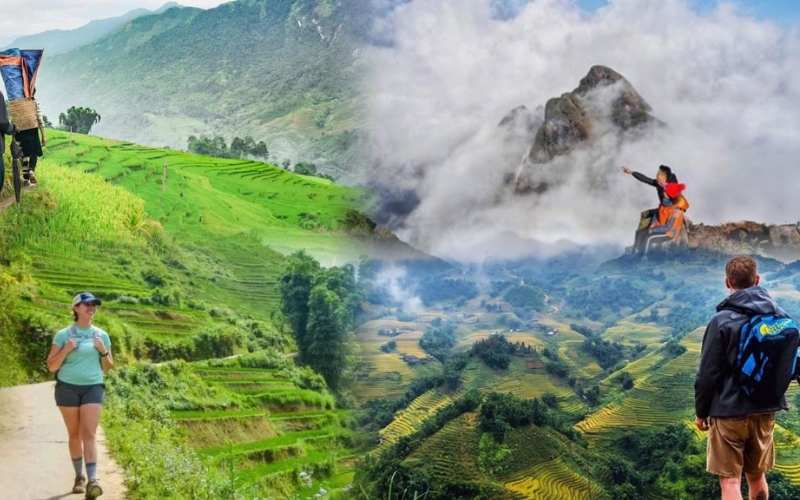
A trek through ethnic villages reveals Sapa’s rich ethnic culture and stunning landscapes
One of the experiences of tourists when traveling to Sa Pa is to walk and visit the villages of the ethnic groups here, the most famous are Ta Van and Lao Chai, about 10 km from the center of Sa Pa. When walking around the villages, you will feel the peace completely separate from the noise and bustle of the town. The beautiful walking route with peaceful mountain scenery, terraced fields and rustic houses interspersed brings a sense of closeness but also very mysterious.
In particular, in late September to October, the terraced fields turn a beautiful golden color when the harvest season begins. This is when the most iconic terraced fields, brilliant and stretching endlessly along the mountain slopes, create the perfect setting for hiking and photography. This is truly the best time to immerse yourself in the charm and peace of the Sa Pa countryside.
Besides the natural beauty, visitors can also learn more about the culture, customs and living habits of some Vietnamese ethnic cultures. You will have the opportunity to experience the warm hospitality of the people and enjoy local delicacies.
> > > If exploring rugged trails, lush valleys, and breathtaking mountain vistas sounds like your kind of adventure, then our Sapa trekking tour in 3 days is just what you need. Check our detailed itinerary here.
Visit Cat Cat Village
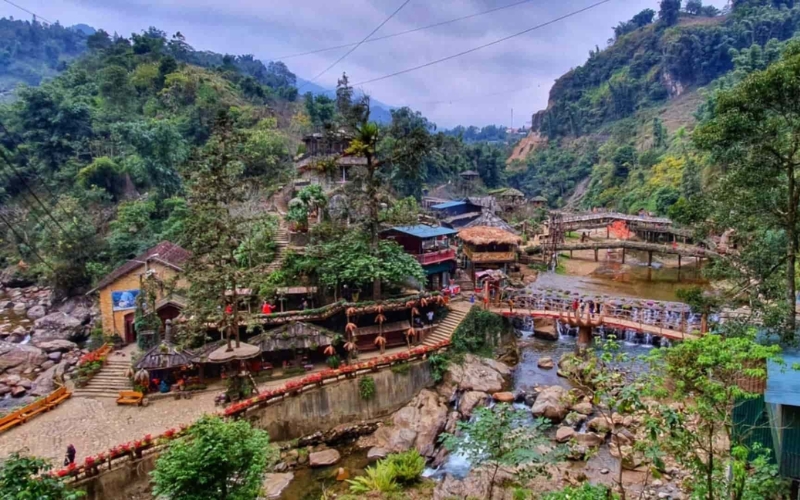
Cat Cat Village offers a glimpse into Sapa’s rich cultural heritage and natural beauty
Known as the most beautiful village in the Northwest, Cat Cat village is a top destination in Sapa, only about 3 km from the center. Cat Cat is home to the Mong people with many customs and traditional crafts such as jewelry making, weaving, silver carving… During a visit to Cat Cat village, visitors will have the opportunity to learn about the life of the H’Mong people and the unique cultural beauty of the ethnic minorities in the mountains.
In addition to sightseeing and checking in, visitors also have the opportunity to enjoy local specialties and buy handicrafts with brocade patterns imbued with the culture of the highlands of Vietnam. One of the must-try experiences is renting ethnic costumes to transform into ethnic boys and girls in extremely special clothes decorated with hairpins.
Experience relaxing herbal baths of the Red Dao people

Herbal baths of the Dao people are the most typical experience when coming to Sapa
Bathing with Red Dao leaves is a “specialty” of tourism in Sapa and also the Northwest region. The traditional herbal bath therapy of the Red Dao people is not only a method of health care, relaxation and stress relief, but also contributes to creating a unique cultural identity of the locality.
According to the Dao people, herbs in the forest have the ability to cure diseases, help the body stay healthy and clear-headed. With their experience, they have combined rare herbs from the mountains and forests with secret formulas to create medicines. This type of bath water is not simply a blend of leaves but is the result of hundreds of years of experience in using herbs to cure diseases and take care of health.
Bathing with herbal medicine of the Dao people is the most typical experience when coming to Sapa and the Northwest region of Vietnam, so in Sapa there are many establishments providing this service, from the villages to the town center. Some quality herbal bath addresses you can experience are Sapa Green Hotel, La Dao Spa, Chi Spa and Sapanapro,…
> > > After soaking in the soothing herbal bath of the Red Dao people, why not explore more of Vietnam’s unique wellness traditions? From steamy herbal saunas to ancient massage rituals, discover the most unforgettable healing experiences in our guide about Vietnamese Wellness Treatments.
Experience riding a train to see Muong Hoa Valley

The Muong Hoa mountain train offers a unique and leisurely way to admire the beauty of the valley
Starting from the center of Sapa town, the train is more than 2 km long, passing through the most beautiful route of Muong Hoa valley and the majestic northwest mountains and forests. Imagine sitting in a train car designed extremely sophisticatedly and classically like a train only found in European fairy tales with the scenery of villages and rolling hills appearing outside the glass windows. More specifically, at sunset or when the fog comes, you will be able to embark on a journey between the clouds with the scenery of the village below appearing and disappearing, very romantic and poetic.
Watch the sunset on O Quy Ho Pass
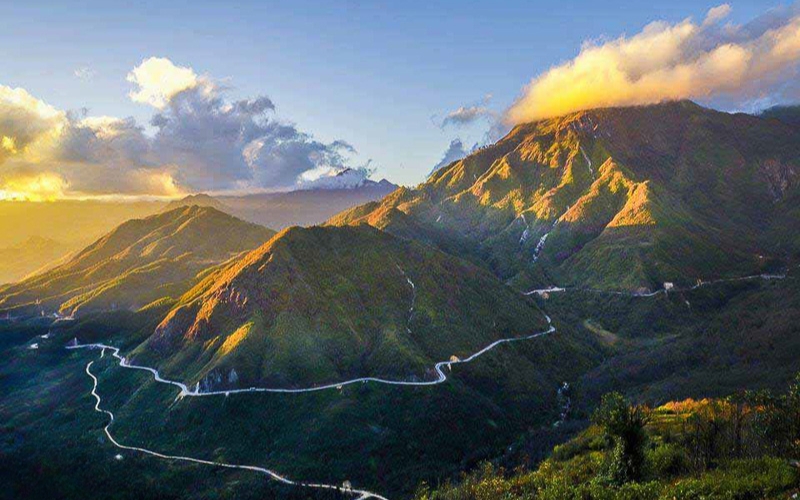
Catch the golden sunset over O Quy Ho Pass for a serene mountain escape
Known as one of the four great mountain passes in Vietnam, O Quy Ho Pass is a favorite destination for many tourists when coming to Sapa. After passing through the majestic waterfalls, you will conquer the peak of O Quy Ho Pass, also known as O Quy Ho Heaven Gate, Sapa Heaven Gate. As one of the most beautiful sunset viewing spots in Sapa, at the top of the pass, you will see the majestic Hoang Lien Son range immersed in a sea of white clouds and fog and the red horizon. Moreover, in each season, O Quy Ho Heaven Gate will give you a different beautiful scene, such as golden terraced fields or sparkling in the pouring water season.
Immerse yourself in the beauty of Sapa’s nature
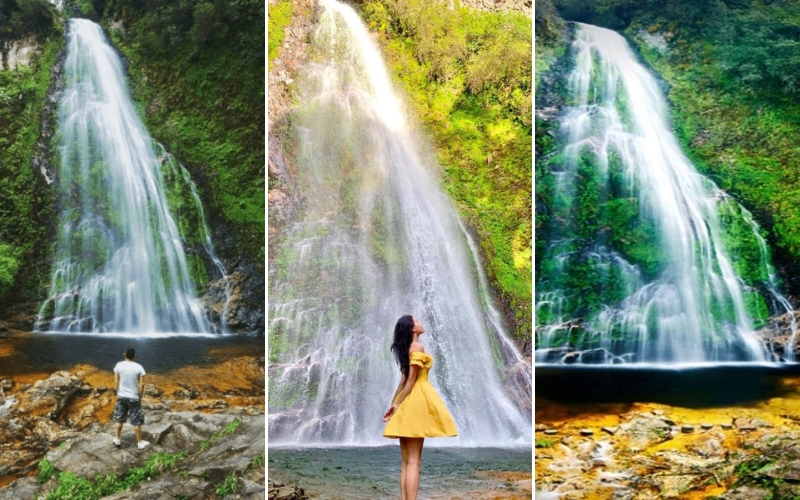
The spectacular Love Waterfall in Sapa
Nestled in the majestic Hoang Lien Son range, with rich and diverse landscapes, SaPa’s nature is always a strong attraction for tourists. There are high mountains, white clouds and unique natural scenery but very poetic and peaceful. Some natural beauties you cannot miss are Ham Rong Mountain, Muong Hoa Valley, majestic waterfalls such as Silver Waterfall and Love Waterfall, ….
Sapa’s beautiful scenery is also adorned by brilliant flower seasons. In early spring, peach blossoms bloom throughout the town and villages, bringing a bustling atmosphere of the new year. Next is the season of pure white plum blossoms, covering the hillsides and valleys. In particular, in October and November, buckwheat flower fields bloom, creating a sea of enchanting pastel pink flowers. Visitors can explore the most beautiful buckwheat flower fields in places such as Lao Chai, Ta Van, or Muong Hoa.
Participate in local markets
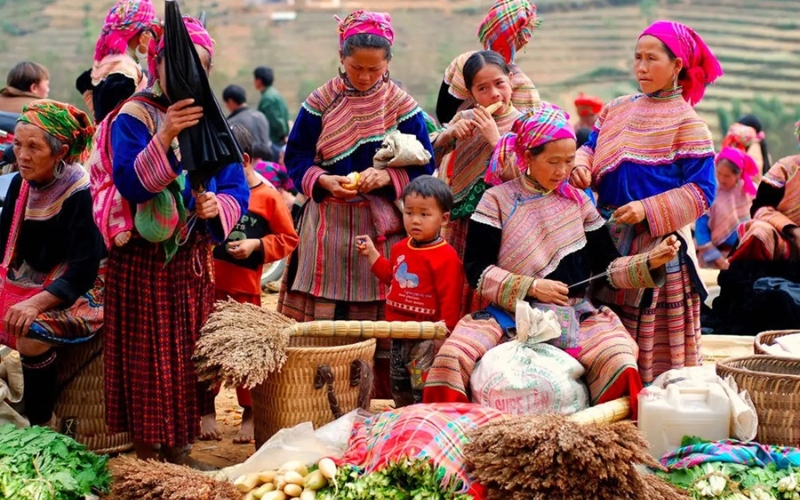
A colorful Hmong market scene in the highlands of Northern Vietnam
Sapa Market is a unique experience for visitors who want to experience the daily life of the local people. Each market is held on a different day and with different frequencies. Some of the most famous markets include Bac Ha Market, Coc Ly Market, Muong Hun Market, etc.
Visitors can buy products sold at the market, from agricultural products, brocade to handicrafts. This is also the place where many unique cultural and artistic activities take place such as folk games, listening to traditional music from ethnic instruments such as flutes, panpipes, etc. This is also an opportunity for local people to meet, make friends and exchange cultures. This scene creates a vivid and colorful picture, a typical highlight of highland culture.
Experience the thrill of the Dragon Cloud Glass Bridge
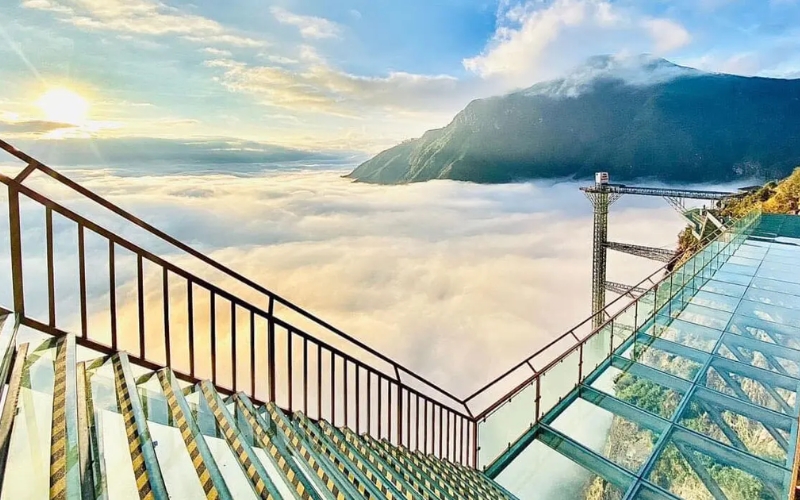
A clear view beneath the glass panels creates an unforgettable thrill
With an impressive height of up to 2200m and being the highest glass bridge in Southeast Asia, this is definitely a challenging experience for tourists who love height-conquering games. This is where you can admire the beauty of Hoang Lien Son range with a new, attractive but also thorny and scary perspective.
The glass bridge system and elevator of the glass bridge are built according to international standards, so visitors will be guaranteed safety in all conditions. Standing on the glass bridge, visitors will get closer to the clouds and immerse themselves in nature, can admire the majestic Fansipan peak amidst the Northwest mountains and forests and terraced fields and hills. In addition, the glass bridge system is more than 500m long, extending out from the cliff at an altitude of more than 1000m above the height of the ravine, giving visitors a heart-stopping yet wonderful experience.
Take photos at famous places
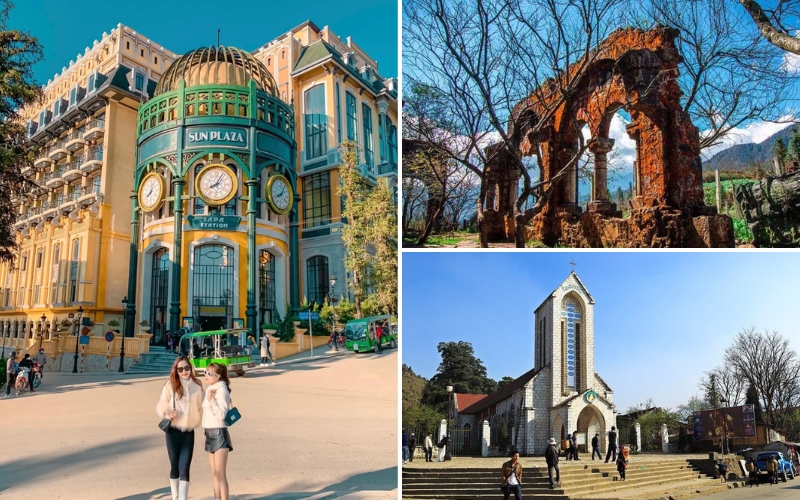
Some of the most popular photo spots in Sapa
Exploring Sapa wouldn’t be complete without capturing iconic moments at its most famous landmarks! Start your journey at Sun Plaza, an architectural icon that towers over the town with its vibrant yellow facade and classic clock tower. Just a short walk away, you’ll find Sapa Stone Church, a historic landmark from the French colonial era with rugged stone walls and a Gothic bell tower. For a more tranquil experience, head to the ancient monastery at Ta Phin, where ivy-covered ruins evoke a sense of mystery and nostalgia. Sit by the arched windows or walk through the ivy-covered walkways for the perfect photo.
Don’t miss the chance to conquer Fansipan Peak, the highest point in Indochina, and capture the iconic triangular peak and the sea of clouds below you. Finally, end your Sapa photography tour at O Quy Ho Pass, one of the highest mountain passes in Vietnam. The breathtaking views from the top are unforgettable. Take panoramic shots of the winding road or capture silhouettes at sunset.
Enjoy the most typical mountain dishes
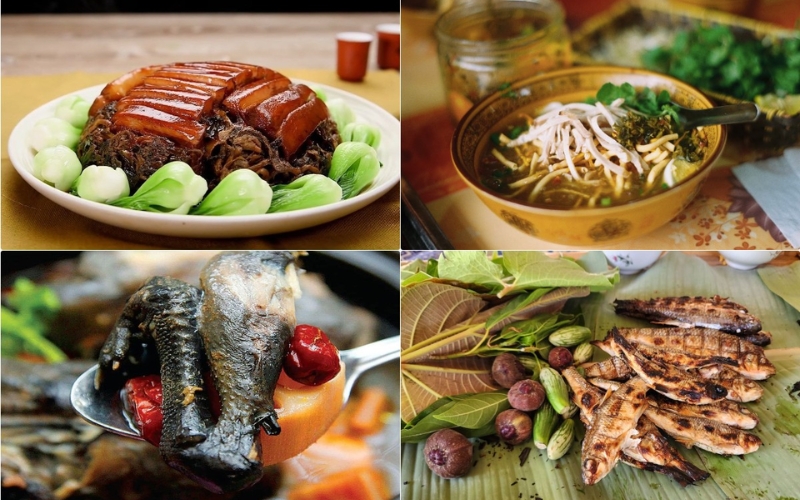
Savor bold, authentic flavors with Sapa’s traditional cuisine
Sapa is famous as an attractive tourist destination in the Northwest region with a characteristic cold climate. Along with that is the attractive scenery, many unique features that nature has bestowed on this land. In addition, visitors to the foggy city are also extremely impressed with the famous Sa Pa specialties, imbued with the cultural flavor of the Northwest people.
The dishes in Sapa are simply prepared, with rustic but very fresh ingredients, marinated with many spices such as mac khen, doi seeds, ginger, lemongrass. The appearance may not be too sophisticated, but these strange dishes will definitely knock your taste buds out. Delicious dishes that cannot be missed when traveling to Sapa are con sui (Sapa pho), thang co (offal and horse meat), buffalo jerky, salmon and grilled dishes.
> > > Looking for an unforgettable adventure in the misty mountains of northern Vietnam? Our Sapa tours take you on a journey through terraced rice fields, vibrant hill tribe villages, and breathtaking landscapes that will leave you in awe.
Tips for the best experience when visiting Sapa
Here are some useful and practical tips you can refer to for your upcoming trip to Sapa:
- Choose the right time to travel: Choose the right time to travel according to your preferences, almost every season of the year in Sapa has favorable weather. You just need to avoid the period from June to July because heavy rains can cause landslides and disrupt your trip.
- Getting to and around Sapa: To get to Sapa, you can choose from many different means of transport, the most popular are buses and night trains. To move around town, use taxis or electric cars if you are traveling in a group to save a lot of money. You need to make sure to confirm the price with the driver to avoid being overcharged.
- Where to stay in Sapa: Choose hotels in the central area for easy access to attractions such as local markets, churches, restaurants, etc. In addition, don’t forget to experience at least one night in a local homestay. Staying overnight in a traditional stilt house in a village like Ta Van or Lao Chai is more than just a place to stay; it’s a real cultural experience. You’ll wake up amidst terraced rice fields, enjoy home-cooked meals with a local family, and experience daily life with ethnic groups like the H’mong or Red Dao.
- Respect local culture and customs: Sa Pa is home to many ethnic minorities, so it’s a good idea to learn about some of their customs and culture in advance to avoid any unnecessary misunderstandings. Dress modestly and politely when entering a local’s home, and always ask permission to take photos as some people may feel uncomfortable.
- Prepare for the weather: Although the sun may seem mild during the day, the UV index is quite high, so you’ll need to pack sunscreen, a hat, an umbrella, and sunglasses. It gets quite chilly at night, so pack a light jacket
- Book a tour guide for your trek: The trails in Sa Pa can be confusing, especially in more remote areas, so hiring a local guide is a smart choice. Most guides come from ethnic communities such as the Hmong or Red Dao and can share unique insights into the culture, customs and daily life of the locals. They will help you navigate safely, connect with the villagers and discover hidden gems you might miss if you were to explore on your own.
- Bring cash: While some hotels, larger restaurants and modern shops in town may accept credit cards, many local businesses including roadside food stalls, markets and village souvenir shops may only accept cash. There are ATMs in the centre of Sa Pa, but they can be unreliable or have withdrawal limits, especially on weekends or during peak tourist seasons when they often run out of cash. That’s why it’s a good idea to bring extra cash before you arrive in Sa Pa.
Hopefully, the list of best things to do in Sapa above will help you easily plan and fully experience all the activities as well as feel the beauty of this town more perfectly. If you’re ready to explore the wonders of Sapa, contact us today to start your Sapa adventure!
Read more:
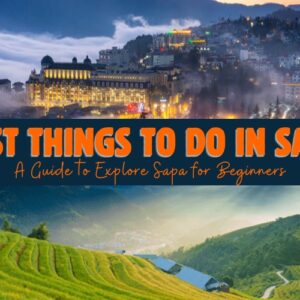

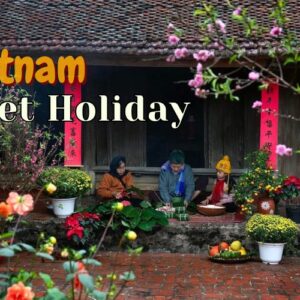
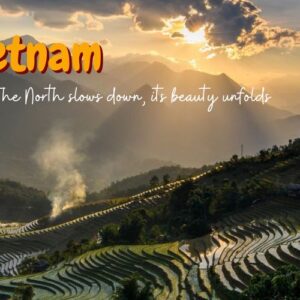
What’s the best time of year to visit Sapa for trekking and scenery?
March to May (spring) and September to November (autumn) are the most recommended times. Spring brings cool weather and blooming flowers, while autumn is famous for golden rice terraces and clear skies. Summer can be rainy, making trails slippery, and winter gets cold and foggy, though it also has a unique misty charm.
I gonna visit Vietnam this Sep, but it the rainy season. Should I go to Sapa this time? Any tips recommend for best time in Sapa in rainy season?
Hi, thank you for reaching out to us! Fyi, you can definitely visit Sapa in September. Although it’s the rainy season, this is also the time when the rice terraces turn golden and reach their most beautiful state during harvest. Rain usually comes in short bursts, often in the afternoon, so plan outdoor activities in the morning. Bring a light rain jacket and waterproof shoes, and enjoy the misty mountain views. Staying a few nights gives you flexibility with the weather.
Best regards,
IDC Travel Team.
This guide is super helpful! I’m planning a trip to Sapa soon, do you think it’s better to visit during the rice harvest season or in spring when the flowers bloom?
Both seasons offer a unique experience in Sapa, so it depends on what you’re looking for. The rice harvest season (typically September to early October) is stunning, with golden terraced fields and vibrant cultural activity in local villages, ideal for photography and cultural immersion. Spring (March–April) brings blooming flowers, especially peach and plum blossoms, creating a colourful, peaceful atmosphere. If you prefer lively landscapes and local festivals, go in autumn, for tranquillity and natural beauty, spring in ideal.